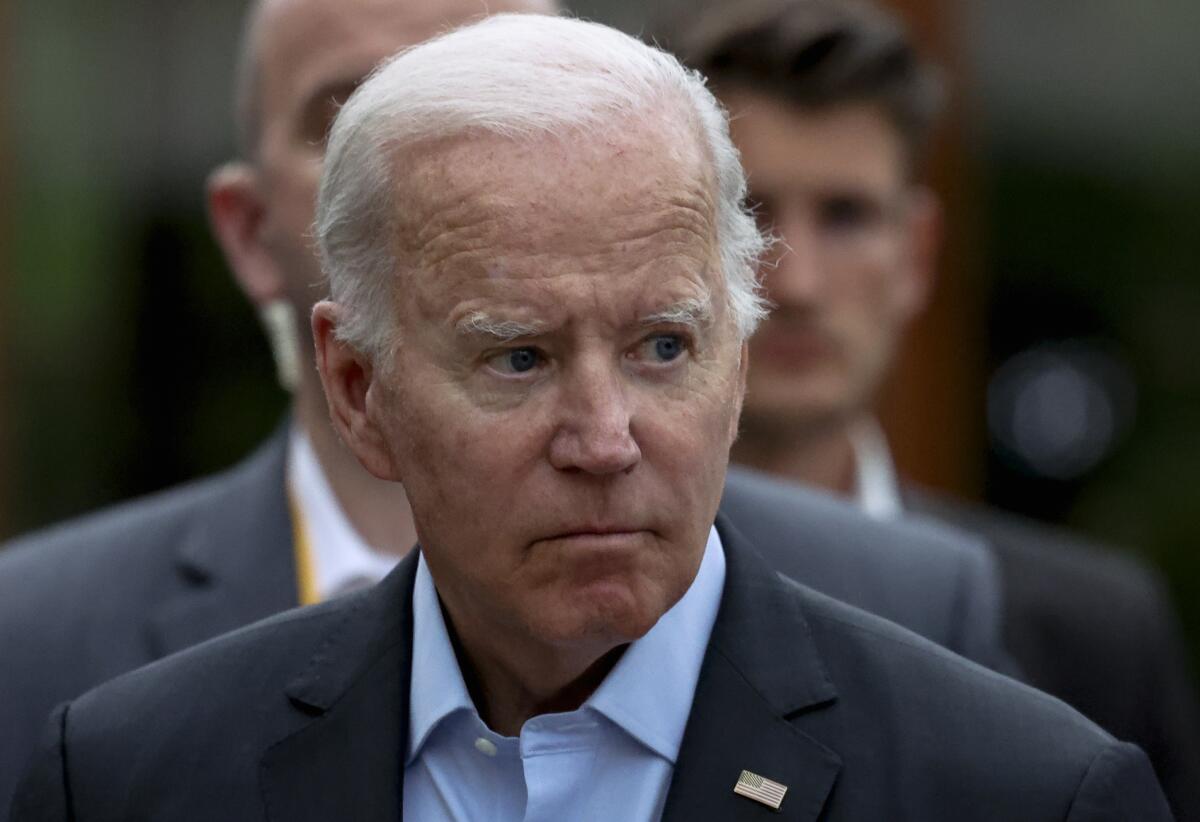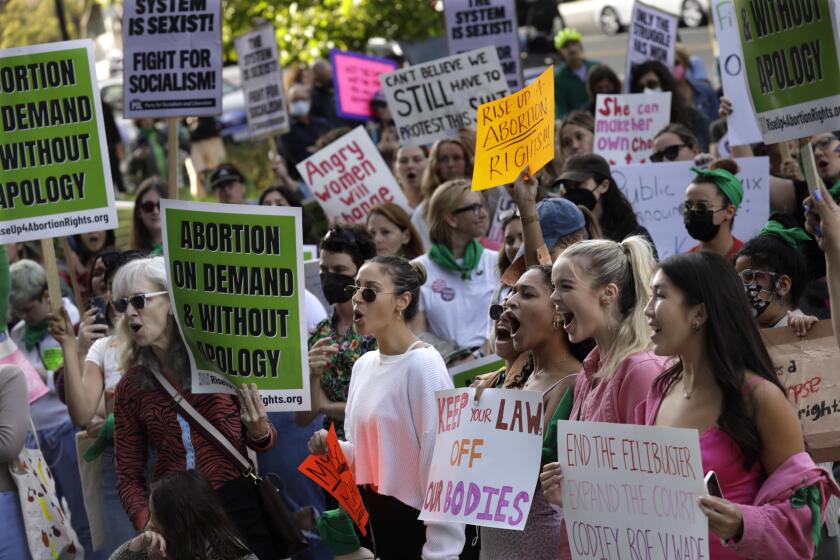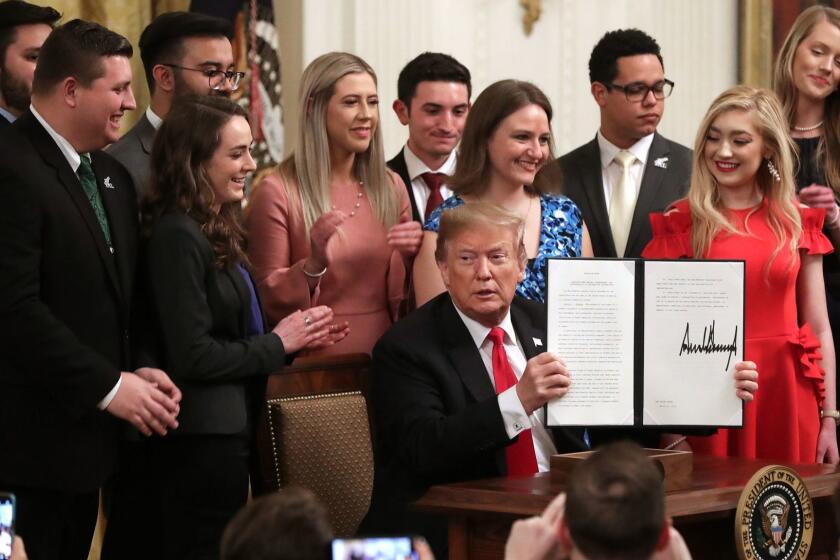News Analysis: Pressure builds on Biden to turn to executive action despite its limits and risks

- Share via
WASHINGTON — He is facing high inflation, a potential recession and a domestic agenda languishing in the Senate. Last week, the Supreme Court overturned Roe vs. Wade, the landmark abortion ruling, and this week upended his climate plans. The looming midterm elections look dire for his party, and his base is frustrated. Pressure is mounting on President Biden to take action.
“The White House needs to move faster and do more on at least the executive actions that we’ve already outlined for them, that we’ve been in discussion with them on,” Democratic Rep. Pramila Jayapal, chair of the Congressional Progressive Caucus, said in an interview. “It feels like the delays overwhelm the actual action.”
If only it were so easy, say those close to Biden, pointing to serious problems facing the president if he were to issue a flurry of executive orders in the coming months. While such actions might satisfy his base, for a time, they are also likely to leave portions of it disappointed and won’t bring about the dramatic change some Democrats are seeking.
Executive orders are at best temporary measures — easily reversed by the next president or overturned in court — and frequently ineffectual. As a creature of the Senate, in which he served for more than three decades, Biden prefers legislating to governing by executive fiat.
If history is a guide, Biden is likely to follow in the footsteps of previous presidents who issued a raft of executive orders ahead of midterm elections. With Congress gridlocked, Democrats and experts say, the president has to be seen as doing something — especially after the Supreme Court jettisoned nearly 50 years of legal protection for those seeking an abortion, something most Democrats view as a fundamental right.
“This is an all-hands-on-deck moment,” said Sen. Patty Murray (D-Wash.), who said she’s urging Biden to “really push the envelope” with what he can do to protect abortion access.
The abortion case crystallizes the conundrum facing Biden and Democrats. While Biden has taken some action — he directed his administration to ensure abortion drugs are available and to help women seeking out-of-state abortions — he has resisted calls to take more aggressive steps pushed by progressives.
Here’s everything you need to know about the U.S. Supreme Court’s decision on Roe vs. Wade.
“I believe we have to codify Roe vs. Wade into law. And the way to do that is to make sure that Congress votes to do that,” Biden said during a news conference Thursday at the end of a NATO summit in Madrid, echoing comments he made the day the ruling came down.
The president added that he felt “extremely strongly that I’m going to do everything in my power which I legally can do in terms of executive orders, as well as push the Congress and the public” to protect abortion rights.
Some Democrats argue Biden’s hesitation to take a bolder approach on abortion rights is emblematic of an overly cautious approach to addressing several issues he promised to tackle as president.
They noted the administration had weeks to prepare for the Supreme Court ruling, a draft of which had been leaked and published in the press, and should have been ready to mount a more robust response.
“We knew this was coming, and so it should’ve been possible within 24 or 48 hours to roll out a set of things that the president could do,” Jayapal said.
Jayapal and other progressives say Biden has balked on moving forward on other Democratic priorities. He has not yet forgiven student debt, for example. The proposal under consideration would waive debt of $10,000 per borrower, an amount that is certain to irk progressives for not going far enough and opponents for potentially exacerbating inflation.
Before addressing other top items on Biden’s agenda, the White House appears to be waiting to see whether it can strike a deal with Democratic Sen. Joe Manchin III (W.Va.), who torpedoed Biden’s social spending plan in December. White House officials hope to revive a bill to address climate change and prescription drug prices — two other priorities Democrats hope to deliver on before November.
A Senate deal addressing climate change gained urgency on Friday after the Supreme Court sharply restricted the Environmental Protection Agency’s power to regulate carbon emissions. It said Congress had to delegate such authority.
Democrats’ frustration with Biden over his hesitation to act also highlights the president’s paradoxical approach to executive orders — he frequently wields the pen. Having issued 91 executive orders to date, the president is on pace to surpass his predecessor in the number of executive orders issued in a four-year term. President Trump issued 220 such orders.
In historical terms, Biden could also surpass other recent presidents. Obama used the pen 276 times over his two terms. George W. Bush signed 291 executive orders over his eight years in office and Bill Clinton issued 364 orders during his tenure.
Most of Biden’s orders came in the first few months of his presidency. He issued 42 executive orders in his first 100 days in office and a total of 77 during 2021, the most by one president in a given calendar year since Jimmy Carter in 1979.
In those early days in office, Biden issued a raft of orders, presidential memorandums and proclamations that focused on tackling the coronavirus pandemic and unwinding his predecessor’s actions, including ending a travel ban on predominantly Muslim countries. Biden also rejoined the Paris climate accords and recommitted funding to the World Health Organization.
A seated President Trump handed commemorative pens to his wife, daughter and eight others who hovered around his desk, then theatrically held up for the cameras the latest executive order bearing his oversize signature.
“I’m not making new law. I’m eliminating bad policy,” Biden said in February 2021, remarks that also highlighted the limits of executive action.
Matt Bennett, a strategist and founder of the Democratic centrist think tank Third Way, said the president appears to be guided by his keen awareness that Trump wiped out many of Obama’s orders — a practice Biden has also pursued.
“His reluctance is both his innate sense that this isn’t a way to run a railroad but also his sense that executive actions are very flimsy and not a sturdy way of making policy,” Bennett said. “When the next administration comes along, they can do what he did — which is sign a bunch of executive actions undoing them.”
Biden has used the pen in more targeted ways this year. He marked the second anniversary of George Floyd’s murder by a Minneapolis police officer in May by signing an order designed to hold police officers accountable for misconduct and strengthen public safety. Biden acknowledged the limits of the order, which was the result of a more sweeping police reform effort in Congress that collapsed last year.
Biden last month issued an order to combat a spate of anti-LGBTQ bills that have cropped up in conservative state legislatures, including Florida’s law that prohibits teaching on sexual orientation and gender identity. He also launched a task force to combat online harassment.
Overall, Biden’s directives have generally been a mix of actual execution and “planning to make plans,” according to Andrew Rudalevige, a professor at Bowdoin College who studies the effectiveness of presidential executive orders.
The majority of his orders fall into a “review and report” category, which direct departments and agencies to consider issuing updates to existing policies and rules. Some of those orders have resulted in new regulations, Rudalevige said, while others have stalled or are facing court challenges.
Activists warn that the failure to deliver on promises to Black voters could hurt Democrats in the midterm election.
And though Biden has expressed disdain with his predecessor’s penchant for bypassing Congress, he’s continued Trump’s use of “flowery” wording at the outset of his orders compared with previous presidents’ more legalistic tone, according to Rudalevige’s research.
Biden’s orders, which boast the longest word count in the last 60 years, often include press release-style language.
Comparing executive orders is only part of the picture, Rudalevige said, given that presidents also use proclamations and memoranda to achieve policy goals. Some of Obama‘s and Trump’s boldest unilateral actions were not carried out through executive orders.
Political scientists are surprised the White House hasn’t used executive action to try to tamp down inflation and soaring gas prices, an area where Biden could take unilateral steps that may face court challenges but could relieve some of the short-term, economic pain.
Earlier this month, Biden called on Congress to lift the federal gas tax for three months — a move Obama previously called a “gimmick” — but stopped short of issuing any executive orders. He also called on states to suspend their own fuel taxes and for oil companies to lower costs.
Such reluctance may not last much longer, said Norman Ornstein, a political scientist at the American Enterprise Institute.
“The temptation to use executive action naturally goes up,” he said, “as the ability to get things done in Congress goes down.”
More to Read
Get the L.A. Times Politics newsletter
Deeply reported insights into legislation, politics and policy from Sacramento, Washington and beyond. In your inbox three times per week.
You may occasionally receive promotional content from the Los Angeles Times.














